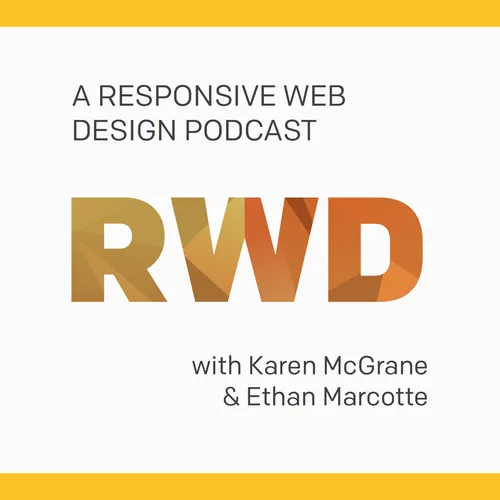
A Responsive Web Design Podcast
A podcast from Karen McGrane and Ethan Marcotte, who interview the people who make responsive designs happen.
- Update frequency
- every 7 days
- Episodes
- 157
- Years Active
- 2014 - 2018

Episode #97: Google Fonts
Rob Giampietro tells us about a year-long process to redesign Google Fonts, making the web faster and more beautiful with hundreds of free, open-source typefaces.
Mon 15 Aug 2016

Episode #96: Texas State
Michael Edelstone and Nick Wing from Texas State describe a responsive design and CMS replatforming that treats website visitors and content editors as if they are both users of the system.
Mon 08 Aug 2016

Episode #95: University of Tennessee-Knoxville
What’s different when teams do their second responsive design? Leigh Shoemaker and Michael Purdy describe a process that’s even more collaborative for the University of Tennessee-Knoxville.
Mon 01 Aug 2016

Episode #94: America’s Test Kitchen
Michal Skrzypek and Kate Tetreault describe how the iterative testing culture at America’s Test Kitchen helped them work more collaboratively during a responsive design.
Mon 25 Jul 2016

Episode #93: Communist Party USA
With rising income inequality, the Communist Party USA is attracting new members—and those people are on mobile devices. Mike Votto and Pankaj Jain show how a responsive redesign helps reach them.
Mon 18 Jul 2016

Episode #92: Vox Media Performance
A mobile-first perspective is also a performance-first perspective at Vox Media. Dan Chilton and Guillermo Esteves talk about how they helped build a culture of performance.
Mon 11 Jul 2016

Episode #91: Cincinnati Art Museum
Even though the Cincinnati Art Museum might later want to introduce apps for in-gallery use, the first order of business was a responsive website. Nicole Kroger and Jeff Webster tell us why.
Mon 04 Jul 2016

Episode #90: Marvel App
Prototyping tool Marvel App needed a style guide to enforce brand consistency. Colm Tuite and Yavor Punchev advocate for single-purpose CSS classes.
Mon 27 Jun 2016

Episode #89: American Economic Association
How many economists read American Economic Association journals on their phone? Jenna Kutz and Matt Griffin describe a process that makes the AEA more accessible to everyone.
Mon 20 Jun 2016

Episode #88: Sonos
How does responsive design fit in to an ecosystem based mostly on apps? Zach Forrest explains that design patterns created for Sonos may eventually extend from web to native apps.
Mon 13 Jun 2016

Episode #87: WBUR
Who hasn’t fantasized about (and feared) a gut renovation of their website? Tiffany Campbell and Scott Dasse describe the redesign and relaunch of a beta site for WBUR.
Tue 07 Jun 2016

Episode #86: Carnegie Library of Pittsburgh
If the goal of a library is to respond to the needs of the community, then its website should do the same. Toby Greenwalt and Matt Griffin describe the redesign of the Carnegie Library of Pittsburgh.
Mon 30 May 2016

Episode #85: Ministry of Social Development
Why go responsive for MyMSD, a service that helps people in New Zealand manage their benefits? Julia McConnell and Miriam Walker say their research showed people were likely to use low-end smartphone…
Mon 23 May 2016

Episode #84: Curbed
The relaunch of Curbed includes an updated CMS platform and a new brand identity. Lauren Rabaino and Yesenia Perez-Cruz tell us this redesign reaches readers wherever they are.
Mon 16 May 2016

Episode #83: Responsive Issues Community Group
The Responsive Issues Community Group advocates for tools that make responsive designers and developers’ day-to-day jobs easier. We talk to Mat Marquis about responsive images—and more.
Mon 09 May 2016

Episode #82: Modular Design
Imagine you’re embarking on a CMS replatforming and website redesign. Ethan and Karen explain how a modular design process that puts content modeling and design patterns first will help you.
Mon 02 May 2016

Episode #81: Edible Magazines
Think a small publisher can’t afford to go responsive? They can’t afford not to. Brian Halweil and Lauren Wilson talk about the redesign of the Edible publications in the New York area.
Mon 25 Apr 2016

Episode #80: KLM
Yet another travel brand tells us that responsive design is the right way to go. Frank de Boer and Jan Willem Kluivers describe how they sped up development and improved customer satisfaction at KLM.
Mon 18 Apr 2016

Episode #79: 99% Invisible
If you like podcasts and responsive design, you might like us—but you will LOVE this episode with Kurt Kohlstedt and Andrea Tomingas from 99% Invisible.
Mon 11 Apr 2016

Episode #78: Authentic Jobs
Authentic Jobs advertises open positions for web designers and developers, so it only makes sense that they would want to go responsive. Cameron Moll and Adam Spooner tell us how.
Mon 21 Mar 2016
Disclaimer: The podcast and artwork embedded on this page are the property of A Responsive Web Design Podcast. This content is not affiliated with or endorsed by eachpod.com.